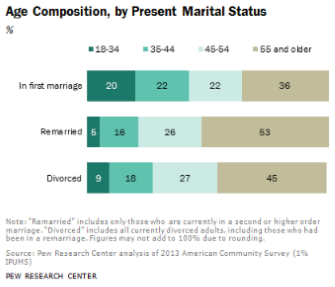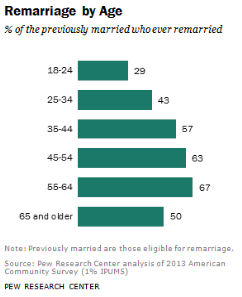8.14: Middle Adult Lifestyles
- Last updated
- Save as PDF
- Page ID
- 10734
Singlehood: According to a recent Pew Research study, 16 per 1,000 adults age 45 to 54 have never-married, and 7 per 1,000 adults age 55 and older have never married in the U. S. (Wang & Parker, 2014). However, some of them may be living with a partner. In addition, some singles at midlife may be single through divorce or widowhood. Bella DePaulo (2014) has challenged the idea that singles, especially the always single, fair worse emotionally and in health when compared to those who are married. DePaulo suggests that there is a bias in how studies examine the benefits of marriage. Most studies focus on only a comparison between married versus not married, which does not include a separate comparison between those who have always been single, and those who are single because of divorce or widowhood. Her research, along with that of others, has found that those who are married may be more satisfied with life than the divorced or widowed, but there is little difference between married and always single, especially when comparing those who are recently married with those who have been married for four or more years. It appears that once the initial blush of the honeymoon wears off, those who are wedded are no happier or healthier than those who remained single. This might also suggest that there may be problems with how the “married” category is also seen as one homogeneous group.
Online Dating: Montenegro (2003) surveyed over 3,000 singles aged 40–69, and almost half of the participants reported their most important reason for dating was to have someone to talk to or do things with. Additionally, sexual fulfillment was also identified as an important goal for many. Alterovitz & Mendelsohn (2013) reviewed online personal ads for men and women over age 40 and found that romantic activities and sexual interests were mentioned at similar rates among the middle-age and young-old age groups, but less for the old-old age group.
Marriage: As you read in Chapter 7, there has been a number of changes in the marriage rate as more people are cohabitating, more are deciding to stay single, and more are getting married at a later age.

As you can see in Figure 8.32, 48% of adults age 45-54 are married; either in their first marriage (22%) or have remarried (26%). This makes marriage the most common relationship status for middle-aged adults in the United States. Marital satisfaction tends to increase for many couples in midlife as children are leaving home (Landsford, Antonucci, Akiyama, & Takahashi, 2005).
Not all researchers agree. They suggest that those who are unhappy with their marriage are likely to have gotten divorced by now, making the quality of marriages later in life only look more satisfactory (Umberson, Williams, Powers, Chen, & Campbell, 2005).
Divorce: Livingston (2014) found that 27% of adults age 45 to 54 were divorced (see Figure 8.32). Additionally, 57% of divorced adults were women. This reflects the fact that men are more likely to remarry than are women. Two-thirds of divorces are initiated by women (AARP, 2009). Most divorces take place within the first 5 to 10 years of marriage. This time line reflects people’s initial attempts to salvage the relationship. After a few years of limited success, the couple may decide to end the marriage. It used to be that divorce after having been married for 20 or more years was rare, but in recent years the divorce rate among more long-term marriages has been increasing. Brown and Lin (2013) note that while the divorce rate in the U.S. has declined since the 1990s, the rate among those 50 and older has doubled. They suggest several reasons for the “graying of divorce”. There is less stigma attached to divorce today than in the past. Some older women are out-earning their spouses, and thus may be more financially capable of supporting themselves, especially as most of their children have grown. Finally, given increases in human longevity, the prospect of living several more years or decades with an incompatible spouse may prompt middle-aged and older adults to leave the marriage.
Gottman and Levenson (2000) found that the divorces in early adulthood were more angry and conflictual, with each partner blaming the other for the failures in the marriage. In contrast, they found that at midlife divorces tended to be more about having grown apart, or a cooling off of the relationship. A survey by AARP (2009) found that men and women had diverse motivations for getting a divorce. Women reported concerns about the verbal and physical abusiveness of their partner (23%), drug/alcohol abuse (18%), and infidelity (17%). In contrast, men mentioned they had simply fallen out of love (17%), no longer shared interests or values (14%), and infidelity (14%). Both genders felt their marriage had been over long before the decision to divorce was made, with many of the middle-aged adults in the survey reporting that they stayed together because they were still raising children. Only 1 in 4 regretted their decision to divorce.
The effects of divorce are varied. Overall, young adults struggle more with the consequences of divorce than do those at midlife, as they have a higher risk of depression or other signs of problems with psychological adjustment (Birditt & Antonucci, 2013). Divorce at midlife is more stressful for women. In the AARP (2009) survey, 44% of middle-aged women mentioned financial problems after divorcing their spouse, in comparison only 11% of men reported such difficulties. However, a number women who divorce in midlife report that they felt a great release from their day-to-day sense of unhappiness. Hetherington (Hetherington & Kelly, 2002) found that among the groups of divorcees she called the enhancers, those who had used the experience to better themselves and seek more productive intimate relationships, or the competent loners, those who used their divorce experience to grow emotionally, but who choose to stay single, the overwhelming majority were women.
Dating Post-Divorce: Most divorced adults have dated by one year after filing for divorce (Anderson et al., 2004; Anderson & Greene, 2011). One in four recent filers report having been in or were currently in a serious relationship, and over half were in a serious relationship by one year after filing for divorce. Not surprisingly, younger adults were more likely to be dating than were middle aged or older adults, no doubt due to the larger pool of potential partners from which they could to draw. Of course, these relationships will not all end in marriage. Teachman (2008) found that more than two thirds of women under the age of 45 had cohabited with a partner between their first and second marriages.
Dating for adults with children can be more of a challenge. Courtships are shorter in remarriage than in first marriages. When couples are "dating", there is less going out and more time spent in activities at home or with the children. So the couple gets less time together to focus on their relationship. Anxiety or memories of past relationships can also get in the way. As one Talmudic scholar suggests "when a divorced man marries a divorced woman, four go to bed." (Secombe & Warner, 2004).
Post-divorce parents gatekeep, that is, they regulate the flow of information about their new romantic partner to their children, in an attempt to balance their own needs for romance with consideration regarding the needs and reactions of their children. Anderson et al. (2004) found that almost half (47%) of dating parents gradually introduce their children to their dating partner, giving both their romantic partner and children time to adjust and get to know each other. Many parents who use this approach do so to avoid their children having to keep meeting someone new until it becomes clearer that this relationship might be more than casual. It might also help if the adult relationship is on firmer ground so it can weather any initial push back from children when it is revealed. Forty percent are open and transparent about the new relationship at the outset with their children. Thirteen percent do not reveal the relationship until it is clear that cohabitation and or remarriage is likely. Anderson and colleagues suggest that practical matters influence which gatekeeping method parents may use. Parents may be able to successfully shield their children from a parade of suitors if there is reliable childcare available. The age and temperament of the child, along with concerns about the reaction of the ex-spouse, may also influence when parents reveal their romantic relationships to their children.
Rates of remarriage: The rate for remarriage, like the rate for marriage, has been declining overall. In 2013 the remarriage rate was approximately 28 per 1,000 adults 18 and older. This represents a 44% decline since 1990 and a 16% decline since 2008 (Payne, 2015). Brown and Lin (2013) found that the rate of remarriage dropped more for younger adults than middle aged and older adults, and Livingston (2014) found that as we age we are more likely to have remarried (see Figure 8.33). This is not surprising as it takes some time to marry, divorce, and then find someone else to marry. However, Livingston found that unlike those younger than 55, those 55 and up are remarrying at a higher rate than in the past. In 2013, 67% of adults 55-64 and 50% of adults 65 and older had remarried, up from 55% and 34% in 1960, respectively.

Men have a higher rate of remarriage at every age group starting at age 25 (Payne, 2015). Livingston (2014) reported that in 2013, 64% of divorced or widowed men compared with 52% of divorced or widowed women had remarried. However, this gender gap has narrowed over time. Even though more men still remarry, they are remarrying at a slower rate. In contrast, women are remarrying today more than they did in 1980. This gender gap has closed mostly among young and middle aged adults, but still persists among those 65 and older.
In 2012, Whites who were previously married were more likely to remarry than were other racial and ethnic groups (Livingston, 2014). Moreover, the rate of remarriage has increased among Whites, while the rate of remarriage has declined for other racial and ethnic groups. This increase is driven by White women, whose rate of remarriage has increased, while the rate for White males has declined.
Success of Remarriage: Reviews are mixed as to the happiness and success of remarriages. While some remarriages are more successful, especially if the divorce motivated the adult to engage in self-improvement and personal growth (Hetherington & Kelly, 2002), a number of divorced adults end up in very similar marriages the second or third time around (Hetherington & Kelly, 2002). Remarriages have challenges that are not found in first marriages that may create additional stress in the marital relationship. There can often be a general lack of clarity in family roles and expectations when trying to incorporate new kin into the family structure, even determining the appropriate terms for these kin, along with their roles can be a challenge. Partners may have to navigate carefully their role when dealing with their partners’ children. All of this may lead to greater dissatisfaction and even resentment among family members. Even though remarried couples tend to have more realistic expectations for marriage, they tend to be less willing to stay in unhappy situations. The rate of divorce among remarriages is higher than among first marriages (Payne, 2015), which can add additional burdens, especially when children are involved.
Children’s Influence on Repartnering: Does having children affect whether a parent remarries? Goldscheider and Sassler (2006) found children residing with their mothers reduces the mothers’ likelihood of marriage, only with respect to marrying a man without children. Further, having children in the home appears to increase single men’s likelihood of marrying a woman with children (Stewart, Manning, & Smock, 2003). There is also some evidence that individuals who participated in a stepfamily while growing up may feel better prepared for stepfamily living as adults. Goldscheider and Kaufman (2006) found that having experienced family divorce as a child is associated with a greater willingness to marry a partner with children.

When children are present after divorce, one of the challenges the adults encounter is how much influence the child will have when selecting a new partner. Greene, Anderson, Hetherington, Forgatch, and DeGarmo (2003) identified two types of parents. The child- focused parent allows the child’s views, reactions, and needs to influence the repartnering. In contrast, the adult-focused parent expects that their child can adapt and should accommodate to parental wishes. Anderson and Greene (2011) found that divorced custodial mothers identified as more adult focused tended to be older, more educated, employed, and more likely to have been married longer. Additionally, adult focused mothers reported having less rapport with their children, spent less time in joint activities with their children, and the child reported lower rapport with their mothers. Lastly, when the child and partner were resisting one another, adult focused mothers responded more to the concerns of the partner, while the child focused mothers responded more to the concerns of the child. Understanding the implications of these two differing perspectives can assist parents in their attempts to repartner.
Grandparents
In addition to maintaining relationships with their children and aging parents, many people in middle adulthood take on yet another role, becoming a grandparent. The role of grandparent varies around the world. In multigenerational households, grandparents may play a greater role in the day-to-day activities of their grandchildren. While this family dynamic is more common in Latin America, Asia, and Africa, it has been on the increase in the U.S. (Pew Research Center, 2010).
The degree of grandparent involvement also depends on the proximity of the grandparents’ home to the grandchildren. In developed nations, the greater mobility of the society can mean that grandparents may live long distances from their grandchildren. Technology has brought grandparents and their more distant grandchildren together. Sorenson and Cooper (2010) found that many of the grandfathers they interviewed would text, email, or Skype with their grandchildren in order to stay in touch.

Cherlin and Furstenberg (1986) describe three styles of grandparents: Remote: Thirty percent of grandparents rarely see their grandchildren. Usually they live far away from the grandchildren, but may also have a distant relationship. Contact is typically made on special occasions, such as holidays or birthdays. Companionate: Fifty-five percent of grandparents were described as “companionate”. These grandparents do things with the grandchild but have little authority or control over them. They prefer to spend time with them without interfering in parenting. They are more like friends to their grandchildren. Involved: Fifteen percent of grandparents were described as “involved”. These grandparents take a very active role in their grandchild’s life. They children might even live with the grandparent. The involved grandparent is one who has frequent contact with and authority over the grandchild. Grandmothers, more so than grandfathers, play this role. In contrast, more grandfathers than grandmothers saw their role as family historian and family advisor (Neugarten and Weinstein, 1964).
Bengtson (2001) suggests that grandparents adopt different styles with different grandchildren, and over time may change styles as circumstances in the family change. Today more grandparents are the sole care providers for grandchildren, or may step in at times of crisis. With these changes grandparents are redefining how they see their role in the family with fewer adopting a more formal role (Hayslip, Henderson & Shore, 2003).
Early research on grandparents has routinely focused on grandmothers, with grandfathers often becoming invisible members of the family (Sorensen & Cooper, 2010). Yet, grandfathers stress the importance of their relationships with their grandchildren as strongly as do grandmothers (Waldrop et al., 1999). For some men, this may provide them with the opportunity to engage in activities that their occupations, as well as their generation’s views of fatherhood and masculinity, kept them from engaging in with their own children (Sorenson & Cooper, 2010). Many of the grandfathers in Sorenson and Cooper’s study felt that being a grandfather was easier and a lot more enjoyable. Even among grandfathers that took on a more involved role, there was still a greater sense that they could be more light-hearted and flexible in their interactions with their grandchildren. Many grandfathers reported that they were more openly affectionate with their grandchildren than they had been with their own children.


